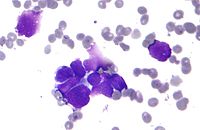
Photo from wikipedia
Abstract The introduction of highly active antiretroviral treatment (HAART) for acquired immunodeficiency syndrome (AIDS) has led to a significant decrease in the incidence of Kaposi’s sarcoma (KS) in recent years.… Click to show full abstract
Abstract The introduction of highly active antiretroviral treatment (HAART) for acquired immunodeficiency syndrome (AIDS) has led to a significant decrease in the incidence of Kaposi’s sarcoma (KS) in recent years. However, a concomitant increase in racial disparities in KS has arisen. Here, we analyze data from the National Cancer Institute’s Surveillance, Epidemiology, and End Results (SEER) Program for epidemiology and survival of Kaposi’s sarcoma by race. The highest incidence was observed among Black patients (incidence rate (IR), 1.189; 95% confidence interval (CI), 1.092–1.189), followed by White patients (IR, 0.486; 95% CI, 0.473–0.498). Relative survival at 1, 3, and 5 years differed significantly by race, with White patients having the highest survival rates (84.26%, 77.79%, and 74.79% at 1, 3, and 5 years respectively) and Black patients demonstrating the lowest (71.50%, 61.37%, and 57.38%), with intermediate survival rates in Asians/Pacific Islanders (AAPI) (80.62%, 71.19%, and 67.28%) and American Indians/Alaska Natives (AIAN) (80.56%, 61.45%, and 61.45%). We conclude that there are significant racial disparities in the incidence, epidemiology, and survival of KS.
Journal Title: Clinical, Cosmetic and Investigational Dermatology
Year Published: 2022
Link to full text (if available)
Share on Social Media: Sign Up to like & get
recommendations!